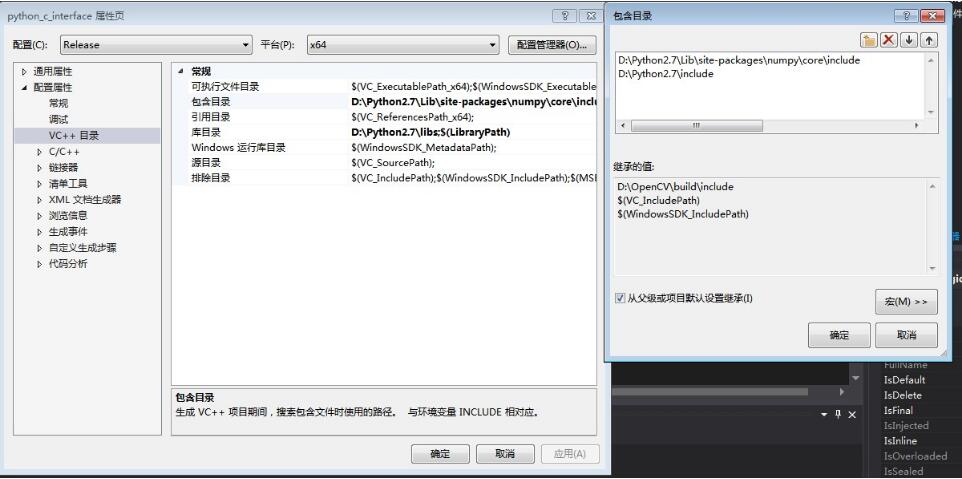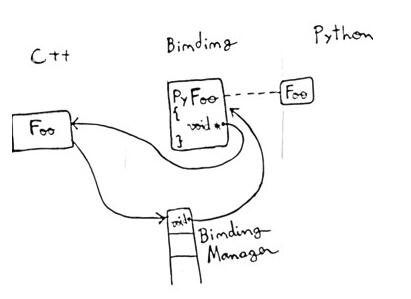- ubuntu12.04环境下使用kvm ioctl接口实现最简单的虚拟机
- Ubuntu 通过无线网络安装Ubuntu Server启动系统后连接无线网络的方法
- 在Ubuntu上搭建网桥的方法
- ubuntu 虚拟机上网方式及相关配置详解
CFSDN坚持开源创造价值,我们致力于搭建一个资源共享平台,让每一个IT人在这里找到属于你的精彩世界.
这篇CFSDN的博客文章Python 调用C++封装的进一步探索交流由作者收集整理,如果你对这篇文章有兴趣,记得点赞哟.
我们知道,C++和python各有优缺点,C++可以直接映射到硬件底层,实现高效运行,而python能够方便地来进行编程,有助于工程的快速实现.
那能不能发挥两者的优势将它们结合起来?当然是可以的!有多种方法可以实现它们之间的相互转换.
链接文章中,有提到一个简单的例子,来教我们如何生成可以被python加载的文件.
但是这只能针对简单的数据进行封装,一旦涉及到自定义的类等封装数据,就需要借助第三方库来帮助更好实现.
比如numpy与C++的数据接口.
这里对python调用C++生成的pyd(so/dll)文件进行进一步的探索.

配置为Release平台,不然numpy的头文件无法被包含,导致编译器链接出错.
特别要注意的一点是用cmd生成pyd文件时,VS2013可能要输入: SET VS90COMNTOOLS=%VS120COMNTOOLS%(每次重新打开cmd窗口运行pythonsetup.py build的时候都要输入一次)才能生成成功.

Python中的代码通过CPython等将语句解释为C/C++语言,然后编译器调用binding入口函数,将传进来的PyObject*参数通过PyFloat_AsDouble()等转换成C/C++变量.
这些作为输入变量传进已经写好的C++函数,调用该函数,返回C++结果。最后反过来,将C/C++变量转成CPython可以识别的PyObject*对象返回给python编译器(如函数PyFloat_FromDouble()),完成python到C++的调用.
当C/C++里面的输入变量或者返回值都不是基本类型时,比如自定义的类,那我们同样要按照类里面定义数据的方式以数据的方式来对应改成python能识别的基本类型的组合.
//以Mat的allocator作为基类,Numpy的Allocator作为继承类//这样可以用派生对象指针对基类数据进行操作class NumpyAllocator : public MatAllocator{public: NumpyAllocator() { stdAllocator = Mat::getStdAllocator(); } ~NumpyAllocator() {} UMatData* allocate(PyObject* o, int dims, const int* sizes, int type, size_t* step) const { UMatData* u = new UMatData(this); u->data = u->origdata = (uchar*)PyArray_DATA((PyArrayObject*) o); npy_intp* _strides = PyArray_STRIDES((PyArrayObject*) o); for( int i = 0; i < dims - 1; i++ ) step[i] = (size_t)_strides[i]; step[dims-1] = CV_ELEM_SIZE(type); u->size = sizes[0]*step[0]; u->userdata = o; return u; } UMatData* allocate(int dims0, const int* sizes, int type, void* data, size_t* step, int flags, UMatUsageFlags usageFlags) const { if( data != 0 ) { CV_Error(Error::StsAssert, "The data should normally be NULL!"); // probably this is safe to do in such extreme case return stdAllocator->allocate(dims0, sizes, type, data, step, flags, usageFlags); } //确保当前使用python的C API是线程安全的 PyEnsureGIL gil; int depth = CV_MAT_DEPTH(type); int cn = CV_MAT_CN(type); const int f = (int)(sizeof(size_t)/8); int typenum = depth == CV_8U ? NPY_UBYTE : depth == CV_8S ? NPY_BYTE : depth == CV_16U ? NPY_USHORT : depth == CV_16S ? NPY_SHORT : depth == CV_32S ? NPY_INT : depth == CV_32F ? NPY_FLOAT : depth == CV_64F ? NPY_DOUBLE : f*NPY_ULONGLONG + (f^1)*NPY_UINT; int i, dims = dims0; cv::AutoBuffer<npy_intp> _sizes(dims + 1); for( i = 0; i < dims; i++ ) _sizes[i] = sizes[i]; if( cn > 1 ) _sizes[dims++] = cn; PyObject* o = PyArray_SimpleNew(dims, _sizes, typenum); if(!o) CV_Error_(Error::StsError, ("The numpy array of typenum=%d, ndims=%d can not be created", typenum, dims)); return allocate(o, dims0, sizes, type, step); } bool allocate(UMatData* u, int accessFlags, UMatUsageFlags usageFlags) const { return stdAllocator->allocate(u, accessFlags, usageFlags); } void deallocate(UMatData* u) const { if(!u) return; PyEnsureGIL gil; CV_Assert(u->urefcount >= 0); CV_Assert(u->refcount >= 0); if(u->refcount == 0) { PyObject* o = (PyObject*)u->userdata; Py_XDECREF(o); delete u; } } //基类指针,调用allocate函数进行内存分配 const MatAllocator* stdAllocator;};
上面是先构造好能够相互交互的allocator.
//将PyObject的特性幅值给size,ndims,type int typenum = PyArray_TYPE(oarr), new_typenum = typenum; int type = typenum == NPY_UBYTE ? CV_8U : typenum == NPY_BYTE ? CV_8S : typenum == NPY_USHORT ? CV_16U : typenum == NPY_SHORT ? CV_16S : typenum == NPY_INT ? CV_32S : typenum == NPY_INT32 ? CV_32S : typenum == NPY_FLOAT ? CV_32F : typenum == NPY_DOUBLE ? CV_64F : -1; //.... int ndims = PyArray_NDIM(oarr); //.... const npy_intp* _sizes = PyArray_DIMS(oarr); const npy_intp* _strides = PyArray_STRIDES(oarr); for ( int i = ndims - 1; i >= 0; --i ) { size[i] = (int)_sizes[i]; if ( size[i] > 1 ) { step[i] = (size_t)_strides[i]; default_step = step[i] * size[i]; } else { step[i] = default_step; default_step *= size[i]; } } //.... //这一步直接用PyObject初始化Mat m m = Mat(ndims, size, type, PyArray_DATA(oarr), step); m.u = g_numpyAllocator.allocate(o, ndims, size, type, step); m.addref();
上面是将PyObject对象转为Mat的部分代码,具体可以参考opencv的cv2.cpp文件:..\OpenCV\sources\modules\python\src2 。
//将Mat转换为PyObject*template<>PyObject* pyopencv_from(const Mat& m){ if( !m.data ) Py_RETURN_NONE; Mat temp, *p = (Mat*)&m; //确保数据拷贝不会对原始数据m产生破坏 if(!p->u || p->allocator != &g_numpyAllocator) { temp.allocator = &g_numpyAllocator; ERRWRAP2(m.copyTo(temp)); p = &temp; } //将Mat封装好的userdata指针转给Pyobject* PyObject* o = (PyObject*)p->u->userdata; //引用计数器加一 Py_INCREF(o); return o;}
一个很重要的知识点是,pyd文件跟dll文件非常相似,所以生成dll比较困难的C++代码同样难以生成pyd,C++跟python编译器各自编译特性的区别也会使得转换存在困难,比如C++的动态编译.
类;构造函数和析构函数;虚函数;(多重)公有继承; 。
静态函数;重载(包括大多数操作符重载);引用; 。
模板编程(特化和成员模板);命名空间;默认参数;智能指针.
下面是不能或者比较困难进行转换的C++特性:
嵌套类;特定操作符的重载比如new和delete.
以上为个人经验,希望能给大家一个参考,也希望大家多多支持我。如有错误或未考虑完全的地方,望不吝赐教.
原文链接:https://blog.csdn.net/purgle/article/details/78905669 。
最后此篇关于Python 调用C++封装的进一步探索交流的文章就讲到这里了,如果你想了解更多关于Python 调用C++封装的进一步探索交流的内容请搜索CFSDN的文章或继续浏览相关文章,希望大家以后支持我的博客! 。
我正在处理一组标记为 160 个组的 173k 点。我想通过合并最接近的(到 9 或 10 个组)来减少组/集群的数量。我搜索过 sklearn 或类似的库,但没有成功。 我猜它只是通过 knn 聚类
我有一个扁平数字列表,这些数字逻辑上以 3 为一组,其中每个三元组是 (number, __ignored, flag[0 or 1]),例如: [7,56,1, 8,0,0, 2,0,0, 6,1,
我正在使用 pipenv 来管理我的包。我想编写一个 python 脚本来调用另一个使用不同虚拟环境(VE)的 python 脚本。 如何运行使用 VE1 的 python 脚本 1 并调用另一个 p
假设我有一个文件 script.py 位于 path = "foo/bar/script.py"。我正在寻找一种在 Python 中通过函数 execute_script() 从我的主要 Python
这听起来像是谜语或笑话,但实际上我还没有找到这个问题的答案。 问题到底是什么? 我想运行 2 个脚本。在第一个脚本中,我调用另一个脚本,但我希望它们继续并行,而不是在两个单独的线程中。主要是我不希望第
我有一个带有 python 2.5.5 的软件。我想发送一个命令,该命令将在 python 2.7.5 中启动一个脚本,然后继续执行该脚本。 我试过用 #!python2.7.5 和http://re
我在 python 命令行(使用 python 2.7)中,并尝试运行 Python 脚本。我的操作系统是 Windows 7。我已将我的目录设置为包含我所有脚本的文件夹,使用: os.chdir("
剧透:部分解决(见最后)。 以下是使用 Python 嵌入的代码示例: #include int main(int argc, char** argv) { Py_SetPythonHome
假设我有以下列表,对应于及时的股票价格: prices = [1, 3, 7, 10, 9, 8, 5, 3, 6, 8, 12, 9, 6, 10, 13, 8, 4, 11] 我想确定以下总体上最
所以我试图在选择某个单选按钮时更改此框架的背景。 我的框架位于一个类中,并且单选按钮的功能位于该类之外。 (这样我就可以在所有其他框架上调用它们。) 问题是每当我选择单选按钮时都会出现以下错误: co
我正在尝试将字符串与 python 中的正则表达式进行比较,如下所示, #!/usr/bin/env python3 import re str1 = "Expecting property name
考虑以下原型(prototype) Boost.Python 模块,该模块从单独的 C++ 头文件中引入类“D”。 /* file: a/b.cpp */ BOOST_PYTHON_MODULE(c)
如何编写一个程序来“识别函数调用的行号?” python 检查模块提供了定位行号的选项,但是, def di(): return inspect.currentframe().f_back.f_l
我已经使用 macports 安装了 Python 2.7,并且由于我的 $PATH 变量,这就是我输入 $ python 时得到的变量。然而,virtualenv 默认使用 Python 2.6,除
我只想问如何加快 python 上的 re.search 速度。 我有一个很长的字符串行,长度为 176861(即带有一些符号的字母数字字符),我使用此函数测试了该行以进行研究: def getExe
list1= [u'%app%%General%%Council%', u'%people%', u'%people%%Regional%%Council%%Mandate%', u'%ppp%%Ge
这个问题在这里已经有了答案: Is it Pythonic to use list comprehensions for just side effects? (7 个答案) 关闭 4 个月前。 告
我想用 Python 将两个列表组合成一个列表,方法如下: a = [1,1,1,2,2,2,3,3,3,3] b= ["Sun", "is", "bright", "June","and" ,"Ju
我正在运行带有最新 Boost 发行版 (1.55.0) 的 Mac OS X 10.8.4 (Darwin 12.4.0)。我正在按照说明 here构建包含在我的发行版中的教程 Boost-Pyth
学习 Python,我正在尝试制作一个没有任何第 3 方库的网络抓取工具,这样过程对我来说并没有简化,而且我知道我在做什么。我浏览了一些在线资源,但所有这些都让我对某些事情感到困惑。 html 看起来

我是一名优秀的程序员,十分优秀!